Strategic Plan Progress Report 2016
- Reports:
- Learning
- Discovery
- Engagement
- Integration
- Access
- Stewardship
President's Letter
Dear Colleagues:
Since 2012, Montana State University’s strategic plan “Mountains and Minds: Learners and Leaders” has been guiding decisions, resource allocation, and programming in pursuit of an even stronger university community. As we look back on the fourth year of the plan, we have much to be proud of: progress in all areas, even exceeding some targets ahead of schedule.
We also have work left to do. As we pass the halfway mark to 2019, we focus as a university on four priority objectives recommended by the Planning Council:
- Learning 1: Assess, and improve where needed, student learning of critical knowledge and skills.
- Discovery 1: Elevate the research excellence and recognition of MSU faculty.
- Integration 1: Increase the integration of learning, discovery and engagement.
- Stewardship 1: Human Resources. Attract, develop and retain the best faculty and staff to achieve the MSU mission.
During the past academic year, we have been looking for ways to invest our resources in these objectives, not at the expense of other good objectives, but to shine a spotlight for a short while in order to make concentrated progress in these areas.
Please join me to reflect on the good work we have accomplished and to renew our efforts on what remains to be achieved. We have so much to celebrate!
Go Cats!
![]()
Waded Cruzado
President
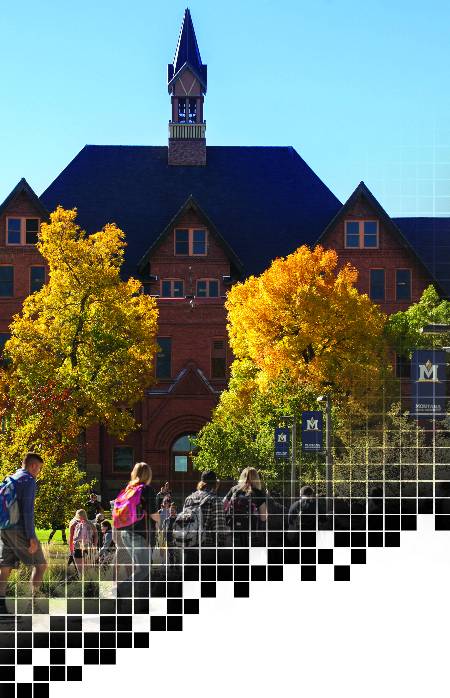
Learning Return to Top Progress Report 2016
MSU has always prepared graduates to meet the challenges of tomorrow. Successful, sought-after graduates are part of our legacy, and preparing students is central to our mission. MSU students learn in the classroom, lab, studio and field, through a hands-on, student-centered curriculum that integrates learning, discovery, and engagement in and out of the classroom.
Goal: MSU prepares students to graduate equipped for careers and further education.
Objective L.1: Assess, and improve where needed, student learning of critical knowledge and skills.
Objective L.2: Increase graduation rates at MSU.
Objective L.3: Increase job placement and further education rates.
Strategies
- Continue to improve assessment of learning outcomes in Core and major programs
- Engage in careful review of the Core curriculum
- Re-invest in and expand successful pilot initiatives for retention and graduation
- Learn from and share best practices in key introductory level course redesigns
- Increase frequency of course offerings to accelerate time to degree
- Improve and add to advising and student success programs, including proactively intervening with at-risk students
Budget alignment(2015–16 investments unless otherwise noted)
- $5 million increase in instructional expenditures and nearly $2 million increase in academic and student support expenditures over FY15 (includes some of the following instructional investments)
- Over $500,000 in strategic investments in math, statistics, and chemistry instructional redesign moved into base budgets
- $575,000 additional investment in summer session courses and programs
- $150,000 invested in gerontology and dietetics programs
- $124,000 new investments in Nursing program development and expansion and $135,000 in the Doctorate of Nursing Practice
- $60,000 in continuing support of the Writing Center’s capacity and scope
- $75,000 in Physics laboratory upgrades
- $35 million new 400-bed residence hall serving first-year students ready for fall 2016 occupancy
Successes
- University of Choice—Once again, Montana State University enrolled a record number of students, 15,688 last fall, up 267 students, or 1.7 percent, from last year’s record. It is the ninth time in the last 10 years that MSU has set an enrollment record. Additionally, this year’s first-year class was the most accomplished, with the highest average SAT, ACT and high school grade-point averages of incoming students. MSU continues to be the school of choice for Montana’s best and brightest students: this year, 66 percent of Montana high school seniors who received Montana University System honors scholarships chose to enroll at MSU.
- New Two-Year Degrees
- The Gallatin Valley is home to approximately 30 photonics and optics companies — the highest per capita concentration of such companies in the U.S. — but skilled photonics technicians are needed to grow the industry. A new Gallatin College MSU associate’s degree in photonics and laser technology will change that. The two-year program will prepare graduates to work as technicians in laser optics and photonics companies.
- Demand for highly trained students in the Culinary Arts has led to development and approval in 2015-16 of an Associates of Applied Sciences in Culinary Arts to be offered through Gallatin College. Coupled with an interdisciplinary four-year curriculum in Hospitality Management or as a stand-alone program, the Culinary Arts AAS will prepare students for a leading industry in Montana and beyond.
- Associate’s-to-Master’s Degree—MSU’s College of Nursing started a new program allowing registered nurses with an associate’s degree and at least two years of nursing experience to earn a master’s degree in nursing — all while continuing to live and work in their home communities. Programs like this ultimately help improve patient outcomes. The first group of students in the program from communities across Montana began taking classes this spring semester.
- The Software Factory—In a collaborative win-win with industry, the Software Factory project puts a small team of computer science students into a real-world software development setting with the goal of meeting a sponsor’s need. Students learn what it is like in the fast-paced world of professional computer development, where you work with your client to assess their need, plan a solution and then meet the team’s deadlines.
- Outstanding Health Professions Preparation —Over the last five-year period, MSU students have enjoyed a 64 percent acceptance rate to medical schools, a 71 percent acceptance rate to dental schools, a 62 percent acceptance rate to physician assistant programs, and an 88 percent acceptance rate to other health professions programs including pharmacy, optometry and chiropractic programs. This compares favorably to the national acceptance rate to allopathic medical schools at 39 percent, to osteopathic medical schools at 35 percent, and to dental schools at 50 percent.
- ‘Unbranded’—Creative experiences and disciplines at MSU impacted the award-winning movie “Unbranded,” a feature-length documentary about the epic journey of four young Texas cowboys, who ride 3,000 miles along the backbone of the Rocky Mountains from the Mexican to the Canadian border on a string of 16 wild mustangs. The adventure was chronicled by MSU film graduate Phillip Baribeau, who directed and was the co-director of photography of the documentary with fellow MSU graduate Korey Kaczmarek. The film was produced by Dennis Aig, director of the MSU School of Film and Photography in the College of Arts and Architecture, and edited by Scott Chestnut, an MSU graduate.
- Student and Alumni Successes
- Josh Carter from Watertown, South Dakota, Zane Huttinga from Amsterdam, Montana, and John Ryter from Hamilton, Montana, each received the prestigious Goldwater Scholarship, the nation’s premier scholarship for undergraduates studying math, natural sciences and engineering. MSU has now produced 67 Goldwater scholars, keeping the university one of the nation’s top institutions for number of recipients.
- Montana Duke Wilson of Poplar, Montana, and Elva Faye Agnes Dorsey, of Browning, Montana, were selected as Udall Scholars in the Tribal Public Policy category. Wilson and Dorsey are among 60 students from 49 colleges and universities to have been selected as 2016 Udall Scholars.
- Levi Birky, the outgoing president of the MSU student body and a junior from Kalispell, Montana, majoring in broad field social studies education, is MSU’s 12th Truman Scholar, one of the most prestigious national scholarships in the United States given to college juniors with demonstrated leadership potential and commitment to public service.
- MSU School of Film and Photography graduate Eddie Roqueta recently won the College Television Award for Best Documentary and earned a primetime Emmy program mention for his film “Silencing The Thunder,” which details the lives of Yellowstone National Park’s free-roaming bison as they stray onto land outside of the park. The College Television Awards, formerly known as the Student Television Awards, were started in 1978 to recognize excellence in student work.
- Daniel Zizzamia, who earned his doctorate in history from MSU’s College of Letters and Science last year, will be one of just a half-dozen scholars to join Harvard’s Environmental Fellows Program this fall. Zizzamia studies environmental history, specifically that of the American West and how coal and fossil deposits have driven the civilization and identities of people west of the Mississippi.
- Student and Alumni Recognition
- Jaimie Lynn Hensley, Michael Andrews, Antonio Wellman and Luke Scheeler, music technology students at Montana State University, had their original musical compositions selected by jury for performance at national and international conferences, festivals and events this year. “It’s a big achievement any time a student can get their work on a national conference or festival,” said Keith Kothman, director of the MSU School of Music. “But, it is an especially impressive accomplishment for these undergraduates. Usually, these opportunities go to graduate students. Their selection shows the exceptional quality we have in the School of Music--both students and their faculty teachers.”
- Lori St. Pierre of Havre, a recent graduate of Montana State University’s online addiction counseling graduate certificate program in the College of Education, Health and Human Development, was one of two people in the United States honored with the Outstanding Continuing Education Student Award by the University Professional and Continuing Education Association (UPCEA). Born and raised on Rocky Boy Reservation, St. Pierre faced health issues, disability and myriad family commitments that hampered her from pursuing her education on many occasions. But St. Pierre’s commitment to education, in spite of the challenges, provides inspiration for others who wish to achieve their goals.
- Detailed architectural drawings and historic research of a homestead on the Gallatin River near Four Corners resulted in a national prize for seven Montana State University architecture students. Graduate students taking professor Maire O’Neill’s course in architecture documentation won second prize in the National Park Service’s Charles E. Peterson Prize for drawings of the Damon Gabriel homestead. The homestead was established in 1889, and its rare two-story hand-hewn log barn was probably built earlier. MSU’s winning team members were: Theresa Lindenau, Hannah Stroebe, Kate Tilleman, Chelsea Holling, Jessica Proctor, Andrea Duroux and Urvi Shah.
- Montana State University music student Zach Maurer, a senior music education major, was selected to participate in the conducting masterclass session at the Northwest Division of the American Choral Director’s Association conference, one of only four students from the six-state region selected to be a full participant / student conductor in the undergraduate division. He is originally from Hastings, Nebraska.
- NIH Director Francis Collins, featured Josh Carter, an MSU undergraduate student in the Honors College double majoring in mechanical engineering and microbiology from Watertown, South Dakota, on his blog, including a write-up by Collins and a 5-minute video post under the title “Curious about Computer Modeling of Proteins.” It is part of a great spring for Carter, who was one of three MSU students to win a Goldwater Scholarship, the nation’s premier scholarship for undergraduates studying math, natural sciences and engineering. Carter’s research has resulted in a total of four high-impact scientific papers.
- It literally took an act of Congress to get Scott Thomas to return to school. Just weeks before he was due to start classes elsewhere, Thomas was diagnosed with amyotrophic lateral sclerosis, more commonly known as ALS or Lou Gehrig’s disease. “Last year, Congress passed the Steve Gleason Act, which allowed Medicare to pay for eye-gaze computers for people like myself,” Thomas said. “Once I knew I could get a computer, I knew it was my opportunity to get back in the game… After my diagnosis, I never imagined I would graduate. Walking across the stage will be an extremely proud moment for my loved ones and for me.”
- Melody Lindsay, a third-year doctoral student in the Department of Microbiology and Immunology in the College of Agriculture and the College of Letters and Science who wants to better understand early life on Earth and the potential for life on other planets has received an Earth and Space Science Fellowship from NASA to allow her to continue sampling hot springs in the world-class laboratory known as Yellowstone National Park. Besides examining the influence of hydrogen on microorganisms that thrive in the extreme conditions of the Norris Geyser Basin and other thermal areas, she will use her fellowship to analyze and present her findings.
- Montana State University alumnus Joseph Azzarelli, who earned a bachelor’s degree in chemistry from MSU in 2010, won the $100,000 grand prize at Massachusetts Institute of Technology's 27th annual Entrepreneurship Competition with a noninvasive, low-cost lung cancer screening technology that he played a key role in developing. The "$100K," as the widely recognized competition is known, was held in May, while Azzarelli was completing his doctorate in chemistry at MIT.
- Kristen Emmett, a doctoral student in MSU’s Department of Ecology in the College of Letters and Science, was awarded a National Science Foundation Graduate Research Program Fellowship. At MSU, Emmett researches in Assistant Professor Ben Poulter’s Ecosystem Dynamics Lab. Poulter has a dual appointment in the Department of Ecology and the Montana Institute on Ecosystems. For her research, Emmett uses a computer model based on how plants grow, compete and respond to disturbances to build “virtual” forests. She then subjects her forests to different climate and greenhouse gas conditions to see how the vegetation and fire regimes respond.
International internships
Two Montana State University students in the Jake Jabs College of Business and Entrepreneurship participated in an international business internship in Japan this summer that complements the college’s undergraduate curriculum and experience, as part of the Starzen Internship program. Carlee Benson and Alex Paterson, both seniors, traveled to Tokyo to participate in the experience, which is noted for its emphasis on cultural education and exchange.
The month-long internship is with the Starzen Company, Ltd., an international trading company and meat manufacturer located in Tokyo.
Bridging Gaps
Thanks to MSU’s Bridges to the Baccalaureate summer program and the Montana Apprenticeship Program, the transition from the small tribal college or high school to the university will be easier for new students each fall. Approximately 15 students, all American Indian or underrepresented minorities, spend the summer in a research lab working alongside Montana State faculty, then showcase their summer research projects at a symposium. For Native American students, it can be daunting to leave the reservation, family, and familiar support systems. The summer programs foster familiarity and confidence to make the transition, while building research skills and intellectual curiosity.
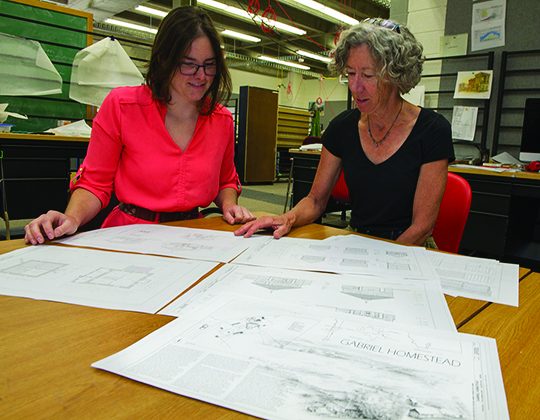
Maire O’Neill’s architectural students earned a national prize for their drawings of a historic local homestead. Photo courtesy Maire O’Neill
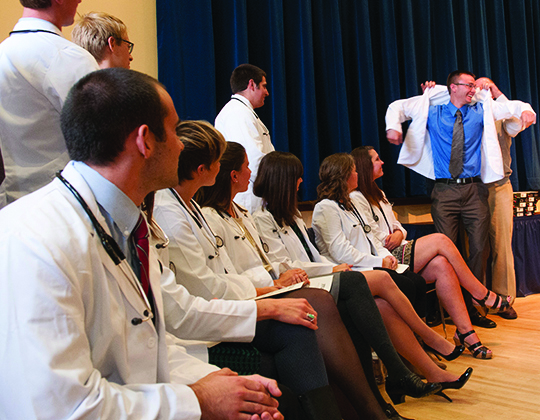
WWAMI Medical Education Program
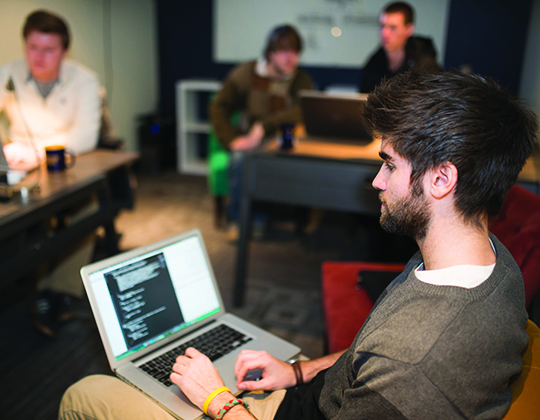
The Software Factory puts computer science students into a real-world software development setting.
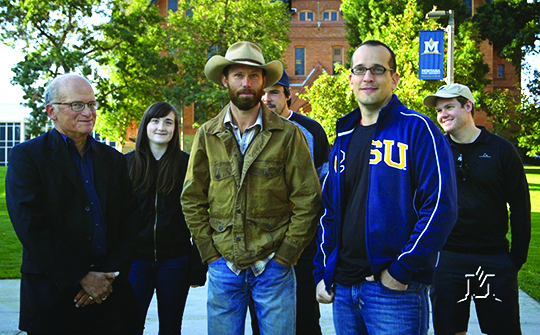
MSU faculty, alumni and students from the “Unbranded” documentary crew.
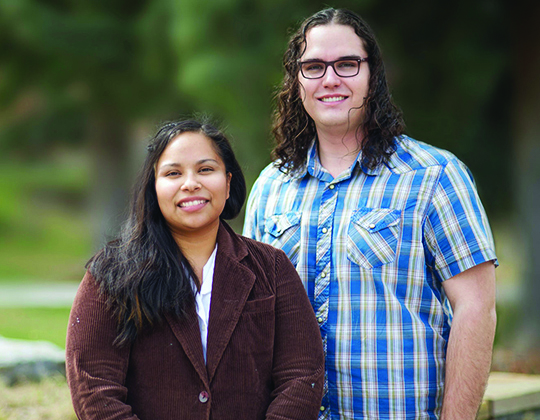
MSU students Elva Dorsey, left, and Montana Wilson, were awarded the prestigious Udall Scholarship from the Morris K. Udall and Stewart L. Udall Foundation. Both students were selected in the Tribal Public Policy category.
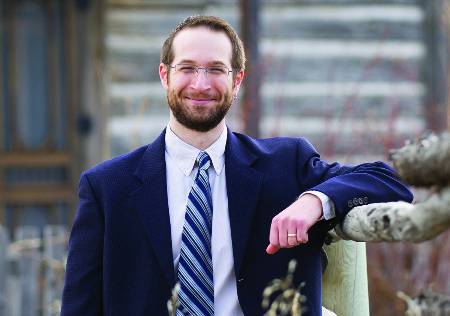
Daniel Zizzamia will join Harvard's Environmental Fellows Program this fall.
Discovery Return to Top Progress Report 2016
Innovative and significant research and creative activities are a recognized hallmark of MSU, where faculty, students, and staff all participate in the creation of knowledge and art.
Goal: MSU will raise its national and international prominence in research, creativity, innovation, and scholarly achievement, and thereby fortify the university’s standing as one of the nation’s leading public research universities.
Objective D.1: Elevate the research excellence and recognition of MSU faculty.
Objective D.2: Enhance infrastructure in support of research, discovery, and creative activities.
Objective D.3: Expand the scale, breadth and quality of doctoral education.
Strategies
- Attract and retain the best faculty and staff with attractive start-up and retention packages
- Improve support for faculty active in research and creative activity through enhanced professional development, additional financial support, and facilities improvements
- Increase the number of grant-active faculty and the number of submitted grant proposals through strengthened grant-writing support, expanded collaboration across disciplines, and opportunity hires
- Expand interdisciplinary efforts in research, creative activity, and graduate education
- Invest in graduate stipends to increase capacity and strengthen recruiting for high quality graduate programs
- Learn from our most productive graduate programs what works for recruitment and retention
- Establish timely pathways to degree completion with recognized milestones and incentives for completion
Budget alignment (2015–16 investments unless otherwise noted)
- $3.3 million in new faculty start-up packages for 2015-16 hires
- $1 million committed to base budgets for new tenurable faculty lines
- $740,000 in market, merit, equity, promotion, and retention increases for tenured and tenure-track faculty
- $600,000 for research data storage
- $700,000 for research space improvements
- $80,000 for increases in Math and Physics graduate assistant stipends
- $240,000 for Native American graduate students in science and engineering committed for FY15 through FY17 to match MSU’s successful Sloan Foundation grant
- $265,000 institutional match for MSU’s NSF ADVANCE grant to improve gender equity in STEM fields
- $9 million of the state’s historic $15 million research initiative garnered by five outstanding MSU applications
Successes
-
Faculty Achievement
- Cathy Whitlock, a professor of earth sciences, was selected for the 2015 Association for Women Geoscientists Professional Excellence Award in the academic/research category. The award recognizes exceptional women who have made distinguished contributions in their professions throughout their careers. Whitlock has worked with 35 Ph.D. and master’s students throughout her career, and about two-thirds of them are women.
- Jessi Smith, a professor in the Department of Psychology, known for her work in diversity, gender studies, motivation and performance, was granted fellow status in both the American Psychological Association and the Association for Psychological Science for her accomplishments in the field of psychology. Smith is the first person to be elected an APA fellow while at MSU and the second in the department to receive the APS honor.
- Ron June, assistant professor of mechanical and industrial engineering, who searches for ways to keep our joints healthy as we age, and Paul Stoy, assistant professor of land resources and environmental sciences, who studies farming practices that may decrease summertime temperatures, both received $500,000 CAREER Awards from the National Science Foundation. The CAREER Award is the NSF’s most prestigious award to support early career development of teacher-researchers.
- Melissa Ragain, a professor of art history, will spend a year at Harvard University as a recipient of a 2016 Radcliffe Institute fellowship. Ragain is one of 54 scholars selected to the 2016–2017 fellowship class at Harvard’s Institute for Advanced Study. It is the first time that a scholar from Montana has been selected for the prestigious fellowship.
- Stephanie McCalla, an assistant professor in the Chemical and Biological Engineering Department, earned recognition and financial support from the Rising Stars program of the Institute of Transitional Health Sciences. McCalla’s research focuses on methods to offer quicker, more cost-effective tests for cardiac biomarkers.
- Recognized Scientific Impact and Collaboration—For the third year running, MSU has received recognition in the CWTS Leiden Ranking for 2016, which ordered the 842 universities in the world with the largest contributions in international scientific journals. MSU is one of only 173 U.S. universities to be included on the list. It is the only university in Montana to be recognized. The ranking is based on universities’ scientific contributions published in scholarly journals, as well as the impact those scientific findings have on the international community.
- Leading the State in Research that Drives the Economy—MSU was awarded $9 million, the lion’s share of the state’s first large scale commitment to university research, for projects that promise to impact the economy. MSU researchers will develop technologies and research in One Medicine, precision agriculture, mental health, energy, and optics.
- New Doctoral Programs
- MSU is now offering a Ph.D. in education, the first in the state, which is designed to prepare graduates for careers in research and as faculty members. The first cohort was admitted for fall 2016.
- The first class of students in MSU’s Doctorate of Nursing Practice program walked across the commencement stage this spring. Eight students earned the highest nursing degree offered in the state, through an innovative distance education program preparing them for Nurse Practitioner roles to serve Montana’s rural and underserved communities.
- The Department of Psychology accepted its first cohort into the Ph.D. program in fall 2015. The program is designed to prepare researchers in cognitive, developmental, health, learning, physiological, and social psychology. Psychologists conducting psychological research work in a wide range of settings such as colleges and universities, health care facilities, federal and state government, small and large businesses, and many other places.
- Path-Breaking Discoveries
- MSU faculty and students were key members of the international team that confirmed a major prediction of Albert Einstein’s 1915 general theory of relativity this year, the “scientific discovery of the century.” MSU has been a member institution of the LIGO Scientific Collaboration since 2007. Physics professor and MSU eXtreme Gravity Institute co-director Neil Cornish leads the MSU LIGO group. Cornish, together with his current and past graduate students developed a novel method for extracting gravitational wave signals directly from the LIGO data. This analysis helped confirm the nature of the signal and the consistency of the signal with the predictions of Einstein’s theory of gravity. Results from the MSU team’s analysis are displayed in the first figure of the discovery paper. ;
- The research of two MSU microbiologists into how bacteria fend off attacks from viruses is included in a new paper published in the scientific journal Nature. Blake Wiedenheft, assistant professor of microbiology and immunology, and graduate student Paul B.G. van Erp joined researchers from Cornell and Johns Hopkins universities to co-author the paper. Bacteria get viral infections just like humans do. The team discovered that bacteria have sophisticated immune systems, called CRISPRs, and their research aims to understand how these immune systems work.
- A research paper published in Nature, authored by Benjamin Poulter, an assistant professor with a dual appointment in MSU’s Department of Ecology and the Montana Institute on Ecosystems, and nearly two dozen other scientists around the world, advances the understanding of how greenhouse gases from forests, grasslands, and agriculture other than carbon dioxide play a role in climate change. Poulter said the study emphasizes that a multi-greenhouse gas perspective is critical to understanding the role of the land in regulating the earth’s atmospheric chemistry and climate.
- Explaining their finding in one of the world’s most prestigious journals, Science, MSU professor John Peters, graduate student Stephen Keable and their colleagues recently announced that sunlight or artificial light can break down nitrogen with a much smaller carbon footprint than a century-old process used by industry to produce the ammonia found in fertilizers. The new discovery could have large implications.
- Two MSU professors and their colleagues have made an important discovery that advances the understanding of a biochemical process underpinning nearly all known life. Will Broderick and Joan Broderick, faculty in the Department of Chemistry and Biochemistry, along with others in the MSU Broderick research group and collaborators at Northwestern University, published their findings in the journal Science.
- High Performance Computing and Communication—MSU’s new high-performance computing cluster, Hyalite, can run complex computer simulations and store multiple gigabytes of data they produce. Coupled with 30 gigabytes per second data transfer capacity, high performance computing resources at Montana State allow researchers to share results with anyone in the world in just a matter of hours. But making sure that research data is well organized, understandable, discoverable and useable by others requires more. Working collaboratively, MSU’s Research Cyberinfrastructure Group and the MSU Library’s Sara Mannheimer, data management librarian, ensure other researchers around the world can find MSU’s raw data and use it to further science.
- Faculty Awards
- Sarah Codd, a professor of mechanical and industrial engineering in the College of Engineering, and Julia Hobson Haggerty, an assistant professor of geography in the College of Letters and Science, are featured in the September 2015 issue of INSIGHT into Diversity as a tribute to their success as women working in science, technology, engineering and math (STEM). The award is presented to 100 women nationally whose work and achievements not only encourage others in their fields, but also inspire a new generation of young women to consider careers in STEM.
- Tricia Seifert, an associate professor in the College of Education, Health and Human Development, recently won the Canadian Association of College and University Student Services’ CACUSS Award of Honor, widely recognized as the association’s most prestigious, given for significant achievement and distinguished contribution to the development and promotion of student services and/or active participation within CACUSS.
- MSU President Waded Cruzado, MSU Vice President for Research and Economic Development Renee Reijo Pera and Frances Lefcort, head of the MSU Department of Cell Biology and Neuroscience, were recognized for their efforts to improve the lives of Montanans who live with serious mental illness and their families as recipients of the 2015 NAMI Hero Awards by NAMI Montana, the Montana chapter of the National Alliance on Mental Illness. The trio were honored for their efforts to establish the MSU Center for Mental Health Research and Recovery.
- Paul Lachapelle, community development specialist for Montana State University Extension and associate professor in MSU’s political science department, was elected president of the International Association for Community Development. MSU Extension community development provides education, research and engagement support for communities in areas including local governance, strategic planning, leadership development, public officials training, citizen board workshops, community foundation education, conflict management, community health and grant writing.
- Blake Wiedenheft, MSU Department of Microbiology and Immunology assistant professor, was invited to give the inaugural lecture in a series encouraging undergraduates to pursue careers in science by the director of the National Institute of General Medical Sciences. Called the NIGMS Director’s Early Career Scientist Lecture, the series is designed to put dynamic early career scientists who are working on exciting problems before an audience of undergraduate students. “I want students to know that it doesn’t matter where they grew up, if they are interested in science there are doors waiting to open for them, and MSU is a key that will help them unlock incredible opportunities,” Wiedenheft said.
- Montana State University research professor Albert Parker, in the Department of Mathematical Sciences in the College of Letters and Science and the MSU Center for Biofilm Engineering, is part of a team awarded the 2015 Scientific and Technological Achievement Award, level 1 from the Environmental Protection Agency for the team’s research into the effectiveness of the performance standards the EPA uses to evaluate antimicrobial products, such as sprays and disinfectants. The EPA made changes to the performance standards it uses in hospitals based on the researchers’ published findings. The award is the highest honor the EPA gives to a research team.
- Hashem Nehrir, a professor in the Electrical and Computer Engineering Department in MSU’s College of Engineering, received the Ramakumar Family Renewable Energy Excellence Award from the IEEE Power and Energy Society. The annual award recognizes a researcher’s contributions to incorporating renewable energy sources into the national power grid and is meant to spur utilization of renewable technologies for power generation, and further research and teaching in the field.
- New Discoveries
- Bacteria may play a larger role in the melting of glaciers than previously suspected, according to a paper published by a recent Montana State University engineering doctoral graduate, Heidi Smith. A portion of Smith’s dissertation was published this month in the journal Nature Biofilms and Microbiomes under the title: “Biofilms on Glacial Surfaces: Hot Spots for Biological Activity.” Smith was a student in the Center for Biofilm Engineering and graduated in May with a doctorate from MSU’s Department of Land Resources and Environmental Sciences in the College of Agriculture.
- An article about an art-science installation that features gravitational waves appeared in a peer-reviewed journal the same month that an international group provided evidence of gravitational waves’ very existence. Montana State University professors were closely involved in both projects. The Einstein Collective, a MSU-heavy group of artists, scientists and educators, collaborated to create Black (W)hole, an installation that was featured on the cover of the February issue of Leonardo, a journal dedicated to the application of contemporary science and technology in the arts. “This is a perfect storm of coincidence that provides a vivid example of the convergence of art and science,” said Bill Shields, interim dean of the MSU College of Arts and Architecture.
- A team of Montana State University paleontologists have identified several new types of dinosaurs from fossil evidence discovered in eastern Idaho, demonstrating the presence of a much more diverse group of theropods in the area than was previously known. The findings were published earlier this month in Historical Biology: An International Journal of Paleobiology. MSU doctoral student L.J. Krumenacker in the MSU College of Letters and Science’s Department of Earth Sciences was the lead author of the study. Others who contributed to the work were Krumenacker’s adviser, MSU paleontology professor David J. Varricchio, MSU graduate student Garrett Scofield and current Boise State University adjunct professor and former MSU graduate student Jade Simon.
- Research from MSU graduate students Alex Michaud and Trista Vick-Majors and undergraduate Will van Gelder has contributed to a broader understanding of the makeup of a large, ancient lake sealed off from the atmosphere for thousands of years under 2,600 feet of the West Antarctic Ice Sheet. The cumulative research provides the first look into the biogeochemisty, geophysics and geology of Subglacial Lake Whillans.
- Thom Hughes, a professor in MSU's Department of Cell Biology and Neuroscience in the College of Letters and Science, is part of a team that has published findings on the development of an improved tool for understanding the workings of the brain. The tool, called genetically encoded voltage indicators, or GEVIs, is a biotechnology that enables researchers to see the electrical activity of individual neural cells “light up” when active. Hughes, along with colleagues at the Yale University School of Medicine and Korea Institute of Science and Technology, summarize recent advances in GEVIs in an article published in the journal Trends in Neurosciences.
- Montana State University professors and doctoral students published a paper in the Journal of Virology that outlines a new — and much faster — methodology for discovering viruses. Rebecca Hochstein, who was awarded a doctorate last fall from MSU’s Department of Microbiology and Immunology in the College of Agriculture and College of Letters and Science, is the study’s lead author. She’s joined by co-authors Max Amenabar and Jacob Munson-McGee, both doctoral candidates in MSU’s microbiology and immunology program and Mark Young, professor in MSU’s Department of Plant Sciences and Plant Pathology in the College of Agriculture.
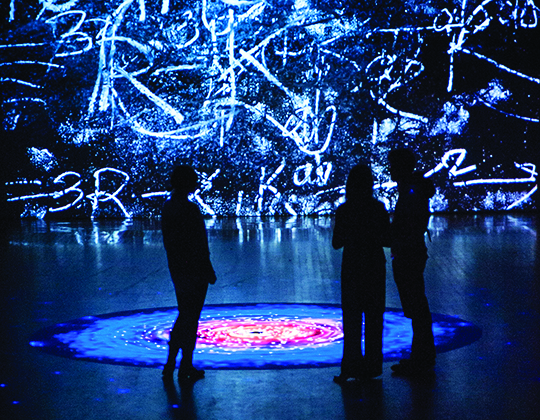
Visitors to the Black (W)hole traveling exhibition are enveloped by a multimedia experience created by the MSU-heavy Einstein Collective.
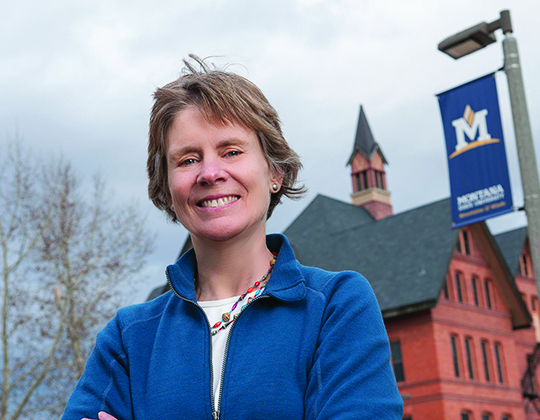
Cathy Whitlock, a professor of earth sciences, was selected for the 2015 Association for Women Geoscientists Professional Excellence Award in the Academic/Research category.
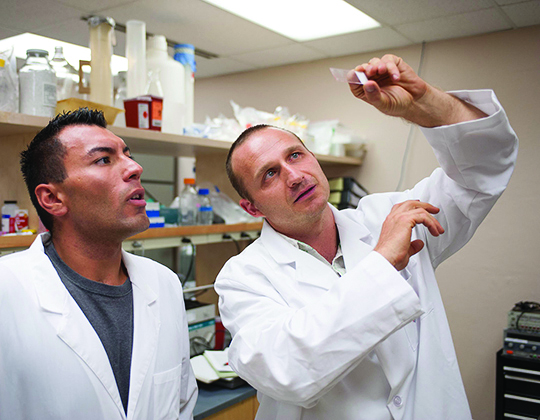
Mechanical and industrial engineering professor Ron June studies a bone sample with
anthropology student Michael Ruiz.
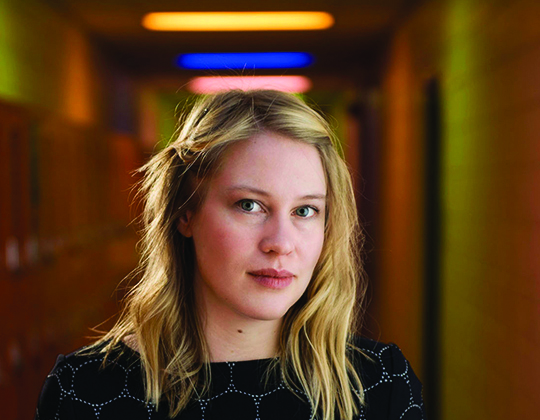
Art history professor Melissa Ragain will spend a year at Harvard University as a
recipient of a 2016 Radcliffe Institute fellowship.
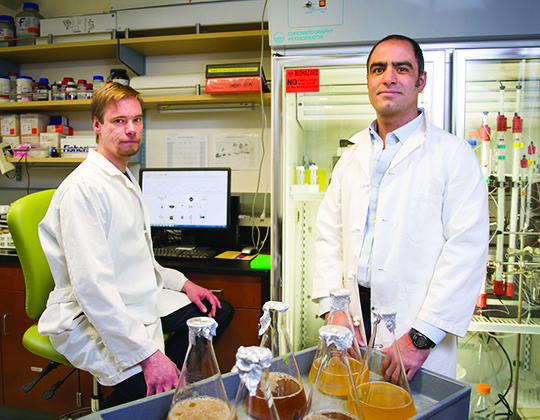
Blake Wiedenheft and graduate student Paul B.G. van Erp joined researchers from Cornell and Johns Hopkins universities to co-author a paper published in the scientific journal Nature.
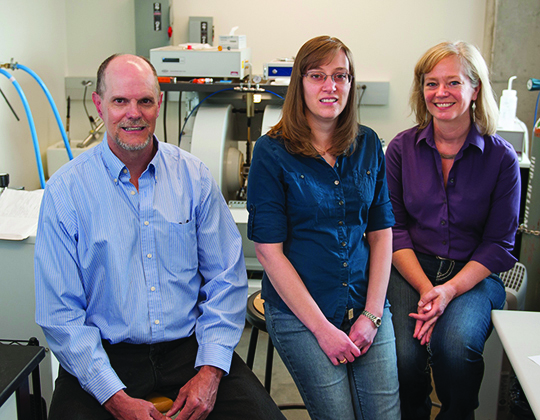
Will and Joan Broderick, a husband-wife team in the Department of Chemistry and Biochemistry, along with others at MSU and collaborators at Northwestern University, published their findings on a vital biochemical process in the May 13 issue of Science.
Engagement Return to Top Progress Report 2016
Engagement is the collaboration between MSU and its local, state, national, and global communities for the mutually beneficial exchange of knowledge and resources in a context of partnership and reciprocity (Carnegie Foundation, 2006). Engagement, a form of scholarship that bridges teaching, research and service, brings the university’s intellectual resources to bear on societal needs (Association of Public and Land Grant University’s Council on Engagement and Outreach).
Goal: Members of the Montana State University community will be leaders, scholars and engaged citizens of their local, national and global communities, working together with community partners to exchange and apply knowledge and resources to improve the human prospect.
Objective E.1: Strategically increase service, outreach, and engagement at MSU.
Objective E.2: MSU graduates will have global and multicultural understanding and experiences.
Objective E.3: MSU students, faculty, and staff will have increased opportunities for leadership
development.
Strategies
- Reorganize and make visible the support structure that connects MSU students, staff, and faculty with engagement information and opportunities
- Emphasize engagement and outreach in faculty hiring and development; provide training and professional development opportunities for service learning and engagement
- Build on the success of and partner with Extension, Museum of the Rockies, and other externally-facing MSU programs
- Engage external stakeholders in thoughtful self-study to enhance partnerships with the private sector
- Underpin leadership and cultural development experiences in curricular, co-curricular, and extra-curricular venues
Budget alignment (2015–16 investments unless otherwise noted)
- $180,000 in student and matching support for student organizations
- $100,000 institutional investment in the Museum of the Rockies and MSU interdisciplinary exhibit “Leisure and Luxury in the Age of Nero: The Villas of Oplontis,” engaging the university and K-12 community
- $80,000 additional institutional investment in the Leadership Institute, developing student leadership capacity
- $60,000 strategic investment in partnership program with tribal colleges to develop articulation and advising relationships
- $60,000 in seed grants for engagement committed starting in FY16, with four recipients in the first round
- Reorganization of student engagement oversight and organization to raise visibility and encourage collaboration with ASMSU
Successes
- Seeding Community Engagement on Campus — Dinosaurs, digital storytelling, cultural collaboration and social services support make up the four projects that received the first round of seed funding from MSU’s Outreach and Engagement Council, designed to bring MSU faculty, staff and students together with local and regional community partners to address the needs of Montana’s communities.
- Supporting K-12 teachers
- The STREAM project (Standards-Based Teaching Renewing Educators Across Montana in Mathematics) uses a combination of centralized workshops, local teacher communities and online learning to provide educators with strategies and tools for improving mathematics instruction. Since 2012, a total of nearly $1.5 million has been awarded to the project, with benefits extending to more than 400 teachers and their students. A partnership spearheaded by MSU and Bozeman Public Schools in collaboration with the University of Montana and the Billings Public School District, the STREAM partnership embodies MSU’s land-grant mission of engagement and outreach to the entire state. More than 100 teachers and administrators have participated in project events, and an estimated 300 more have completed at least one online course.
- For nearly three years, assistant professor Allison Wynhoff Olsen and associate professor Robert Petrone in the MSU Department of English have been working to better understand the challenges of teaching in rural Montana and to create a support system among English teachers across the state, which should ultimately help better prepare Montana students for college. With a $50,000 grant from the Spencer Foundation to bolster their efforts, they are interviewing small groups of English teachers in four different parts of the state—the Hi-Line, the eastern Bakken area, the Flathead valley and the greater Bozeman area—to learn more about teaching strategies, resources, challenges and opportunities.
- Global Filmmaking Partnership —In a unique global partnership funded by the Ford Foundation, up and coming filmmakers from Nigeria, Kenya and Ethiopia travel to MSU’s acclaimed School of Film and Photography to learn cinematography, lighting, interview techniques and post-production strategies. The course is geared to help talented filmmakers create documentary films in their countries that will positively impact society.
- Tribal College Library Collaboration —MSU’s Extended University and the MSU Library’s annual Tribal College Librarians Institute (TCLI) were selected for Explore Science, an educational outreach program created by the Nanoscale Informal Science Education Network, or NISENet. MSU will share a kit of STEM outreach activities with two Montana tribal college libraries, Aaniiih Nakoda College Library in Harlem, Montana, and Stone Child College Library in Box Elder, Montana, The libraries will also receive training resources for using the kits, materials for hosting their own science outreach event and support from MSU and NISENet to help library visitors learn about nanoscale science and engineering in a fun and interactive way.
- Adding Capacity across Montana —MSU’s Montana Manufacturing Extension Center, an outreach program of the College of Engineering at MSU affiliated with the National Institute of Technology’s Manufacturing Extension Partnership, opened a new office in Billings, Montana. The office will serve eastern Montana, collaborate with City College on Montana’s RevUP workforce development grant, and assist manufacturers across eastern Montana with issues related to growth, innovation, efficiency, compliance and management. The eastern Montana MMEC position was made possible by funding championed by Montana Gov. Steve Bullock and approved by the 2015 Montana Legislature.
-
Growing International Education—David Di Maria, associate provost for international programs at Montana State University, was awarded one of just five Neal Presidential Fellowships of the Association of International Education Administrators recognizing new senior international officers with leadership potential. During his fellowship year, Di Maria will visit his mentor’s university, study leadership styles and work on a plan to develop international initiatives at MSU. He will also learn about national and international issues and how they affect individual campuses.
-
Engaging Architecture—More than 100 students from the Montana State University School of Architecture streamed out over old Bozeman to lend a hand to the city of Bozeman’s historic preservation efforts. The students and their faculty documented the exteriors of homes for a city database to help steward historic architecture in the city’s older neighborhoods. The city’s last comprehensive architectural survey was completed in 1984.
- Recognizing Engagement
- In 2014, over 5,200 MSU students engaged in community service, giving 309,000 total service hours, through programs such as the MSU Compact Service Corps Program, MSU America Reads*America Counts and MSU Engineers Without Borders. Among other projects, students, faculty and staff helped provide medical and mental healthcare services, helped local students from pre-K through grade 8 improve their literacy and math skills, and continued to help research, design, develop and implement safe drinking-water wells and sanitary latrines at school locations in Kenya. Efforts like these earned Montana State a spot on the President’s Higher Education Community Service Honor Roll, highlighting the role colleges and universities play in solving community challenges.
- Recognizing the charitable and organizational work of Montana State’s sororities, the National Panhellenic Conference gave the Panhellenic Council at Montana State University a national achievement award for its efforts to maintain the highest standards of the organization. MSU’s council was one of only 22 schools nationwide, and the only school in Montana, to be honored for its achievement. The awards are based on each chapter’s achievements in a total of seven categories: recruitment; Panhellenic structure; communication with the NPC area adviser; judicial procedures; Panhellenic programming; academics; and Panhellenic community impact and relations.
- Montana State University’s American Indian Council recently won the 2015 Hopa Mountain Citizen Leadership group award for the council’s exemplary service to Montana for more than 40 years. The award is given annually to recognize community service. The MSU AIC, part of the American Indian/Native Alaskan Student Success program, is a student run organization that includes MSU American Indian/Alaska Native students, non AI/AN students, their families, as well as campus and community allies and supporters.
- Jennifer Anderson, Extension agent in Rosebud and Treasure counties, received the National Association of Community Development Extension Professionals (NACDEP) Community Development Individual Award for her work developing the Community Foundation of Northern Rosebud County. Katie Weaver, Park County economic and community development agent, led a team of professionals who earned the NACDEP Excellence in Community Development Team Award for creation of a program designed to empower and engage leaders.
- Top Peace Corps Producer—Montana State University was recognized as a top volunteer-producing university by the Peace Corps. There are currently 16 MSU students volunteering worldwide. Alumni from more than 3,000 colleges and universities nationwide have served in the Peace Corps since the agency’s founding, including 471 alumni from MSU. In 2015, Montana ranked No. 3 among states with the highest number of Peace Corps volunteers per capita, with 4.5 volunteers per 100,000 residents.
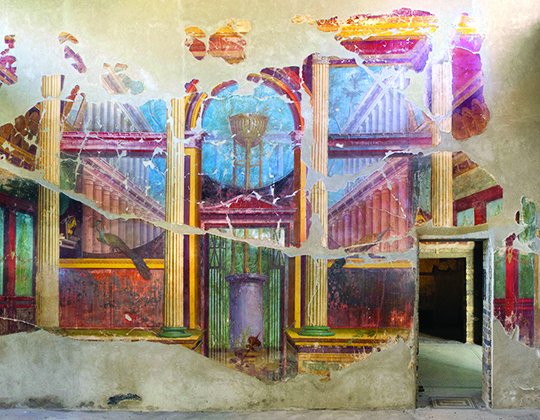
“The Villas of Oplontis Near Pompeii,” curated by art history professor Regina Gee, debuted at the Museum of the Rockies. Photo by Paul Bardagjy
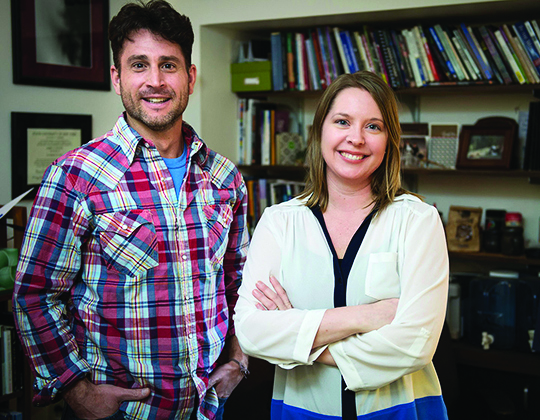
English professors Robert Petrone and Allison Wynhoff Olsen are working to create a support system among rural Montana English teachers.
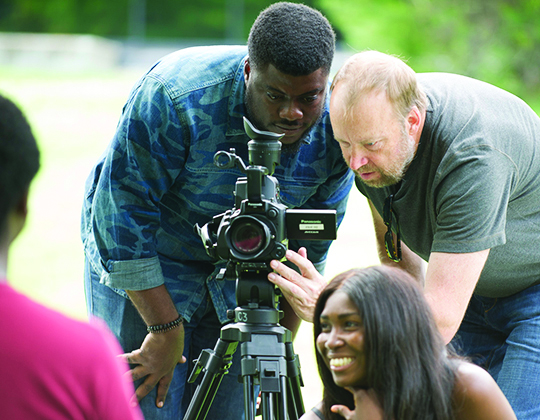
Theo Lipfert, film professor, works with Nigerian filmmakers while they learn documentary filmmaking as part of a month-long, Ford Foundation-funded workshop at MSU.
Integration Return to Top Progress Report 2016
Integrating learning, discovery, and engagement is the marquee feature of the strategic plan. Traditionally, land-grant universities have educated students, conducted research and provided outreach to their communities and states. MSU has gone a step further by regularly integrating research and teaching, practicing service-learning, and combining research with outreach. With this plan, MSU now boldly defines the 21st century land-grant university as one where learning, discovery, and engagement merge seamlessly to the benefit of students, faculty, staff, and the wider community.
Goal: By integrating learning, discovery, and engagement, and by working across disciplines, the MSU community will improve the world.
Objective I.1: Increase the integration of learning, discovery, and engagement.
Objective I.2: Increase work across disciplines.
Strategies
- Explicitly recognize integration in promotion and tenure documents and processes
- Leverage redesign of the Core curriculum to focus on interdisciplinary and research-based inquiry
- Strengthen support for student involvement in discovery and engagement in new and existing integrative programs
- Coordinate, foster, and highlight Community Based Participatory Research projects, to advance efforts through integration, sharing of lessons, pooling of resources, and joint proposals
- Highlight and build upon successes in interdisciplinary curricula and research through interdisciplinary faculty hires, highlighted areas of research strengths, and new interdisciplinary academic programs
Budget alignment (2014–15 investments unless otherwise noted)
- $5.6 million raised from donors in agricultural producer communities for endowed chairs in animal and plant sciences hired to begin in 2016-17 who will integrate learning, discovery, and engagement with the state
- $250,000 in new faculty support through interdisciplinary INBRE and COBRE programs
- $225,000 continued investment to support the interdisciplinary and inter-university Materials Science Ph.D. program
- $80,000 institutional match for the Blackstone Launchpad, providing support for student entrepreneurs to transform ideas into successful start-ups
- $255,000 in support for undergraduate research through the Undergraduate Scholars Program and other research projects
Successes
- Applying Research to the Montana’s Pressing Problems
- The Center for Mental Health Research and Recovery is an interdisciplinary center that is designed to use research to improve the diagnosis and treatment of mental illness through collaborative efforts between neuroscientists, clinicians, engineers, people affected by mental illness and their families. The center was established in the fall of 2014 and hired a permanent director in Dr. Matthew Byerly this year. CMHRR draws on MSU’s research strength in neuroscience, electrical engineering, computer science, biochemistry, psychology and nursing, among other disciplines.
- Kelly Knight and Colter Ellis, assistant professors in the MSU Department of Sociology and Anthropology, have received a grant from the Montana Healthcare Foundation to research health disparities and victim service provider needs among American Indians in Montana. Knight and Ellis began their latest research after a tribal member contacted them about addressing needs and issues common among victim service providers on the reservation.
- A $1 million grant from the W.M. Keck Foundation has enabled researchers at MSU’s interdisciplinary Thermal Biology Institute (TBI), led by Brent Peyton, a professor of chemical and biological engineering, to expand their investigations into how microorganisms thrive in the hostile conditions of Yellowstone’s hot springs, work that may one day lead to new discoveries in medicine, energy, materials and other fields.
- The MSU Center for Interdisciplinary Health Workforce Studies generates research and information regarding key trends in nursing and other health workforces, analyzes that information and shares it with stakeholders. The center’s ultimate mission is to improve the performance of the national health care delivery system. The center, funded entirely by the Gordon and Betty Moore Foundation, has a national focus, but at the same time it’s also concerned with rural healthcare issues of vital importance to Montana.
- MSU’s research into the genetics and breeding of grains has led to the development of crop varieties that offer greater yield, as well as resistance to a number of diseases and pests. The wheat research programs are carried out by MSU’s agricultural research centers. That research is integral to Montana’s wheat crop. MSU is the leading provider of varieties for the 5 million acres of wheat grown in Montana.
- New Endowed Chairs Serve Montana Communities with Research—Montana agricultural producer communities donated historic funding to create the first two endowed chairs in the College of Agriculture. World-class researchers are ready to begin at MSU in 2016-17 to address the needs of the state’s agricultural producers. Hikmet Budak from Sabanci University in Istanbul, Turkey, was selected as MSU’s first Montana Plant Sciences Chair. Timothy DelCurto of Oregon State University was selected as the Nancy Cameron Endowed Chair in Range Beef Cattle Production. Both will work in the MSU College of Agriculture and Montana Agricultural Experiment Station to build significant integrative research programs to make a difference in the lives of producers and the state’s agricultural economy. http://www.montana.edu/news/16169/msu-and-msu-alumni-foundation-announce-delcurto-as-endowed-chair-in-range-beef-cattle-production
- Student-Industry Partnership—In a micro-grid pilot project through NorthWestern Energy, six MSU students in the College of Engineering helped design and install a new power grid that uses solar panels to generate electricity. When power goes out in rural Montana this new and innovative technology could help put the lights back on. It’s the first attempt to back up a medium voltage, high powered distribution line off of batteries and integrate solar to charge those batteries,” said automation technology engineer for NorthWestern Energy, Jon Shafer. Ben Keeley, majoring in electrical engineering, said, “I think this is a great opportunity to really look at alternative energy distribution and generation especially in this reliability case right here, and it’s awesome that we’re going to work on this and use it in the future for future implementation.”
- Translational Science Celebrates Milestone—Montana State University’s Center for Biofilm Engineering marked its 25th anniversary this year. A groundbreaking interdisciplinary center, CBE began with a vision that university research transferred into the commercial sector could benefit society and buoy the pursuit of fundamental science and engineering. Over the past 25 years, the center has led the way in the study of biofilms, in everything from tooth plaque, to the slime coating the inside of pipes in municipal water systems, to the gunk that fouls oil pipelines. In their work over the past 25 years, CBE faculty members have published more than 1,000 papers, been cited over 40,000 times, and have been funded by the Department of Energy, the Department of Defense, the National Institutes of Health, the National Science Foundation, the Environmental Protection Agency, the Department of Agriculture, as well as private funding.
- Sustainable Partnership—The REHAU Montana ecosmart House received a special jury award for leveraging emerging technologies in the commercial building category from the Montana chapter of the U.S. Green Building Council. The REHAU Montana ecosmart house is a residential house designed to use minimal energy and was the result of partnerships between MSU students, faculty, alumni, and industry. Students from diverse disciplines contributed, including architecture students who turned concept sketches into architectural drawings, business students who studied the return on investment of the various components of the house, and engineering students who contributed to the design of the heating and cooling systems. Meanwhile, the entire process was documented by students in the MSU School of Film and Photography.
- Integrative Dietetics Program—The MSU Didactic Program in Nutrition and Dietetics prepares graduates to be successful in obtaining accredited supervised practice programs, such as the Montana Dietetic Internship. The program is a student-centered curriculum that promotes an understanding of sustainable food systems in relationship to health. It also fosters a strong commitment to the community through service learning and engagement. The Montana Dietetic Internship at MSU is a non-degree practice experience for graduates of the Didactic Program in Nutrition and Dietetics. After completing the internship, students are eligible to take the national board exam to become certified as a registered dietician. Interns serve in urban and rural community clinic settings throughout the state.
- This House of Interdisciplinarity—The late writer Ivan Doig, a presiding figure in the literature of the American West, was the author of 16 significant books, and he also created content that filled dozens of storage cartons: typewritten notes, neatly filled dime store notebooks, annotated 3x5 cards, and clearly labeled folders of clippings, photographs and correspondence, nearly all about his beloved Montana. That archive, acquired by Montana State University, will be completely digitized for public access by the staff of the MSU Library’s Special Collections. As part of the acquisition, the MSU College of Letters and Science will integrate the collection into university teaching and research, including a scholarly conference named for Doig.
- Business Student Entrepreneurs for Charity—Teams of Montana State University business students turned $25 into more than $5,500 in just three weeks, and the students then donated those funds to three local non-profit organizations, in the “Entreprentice Challenge,” part of management professor Brent Rosso’s upper-division class on entrepreneurship in the MSU Jake Jabs College of Business and Entrepreneurship. The student teams launched a variety of creative ventures, including a homemade bike taxi, a mobile photography service and a dog walking service, among others. Other teams manufactured and sold products like metal bottle openers, apparel, furniture, stickers and jewelry. Some of the ventures continued on as real businesses even after the class project had concluded. Rosso said, “It was really meaningful for all of us to see how doing well and ‘doing good’ can go hand-in-hand.”
- Entrepreneurship to Help the Elderly—Honors college and graphic design student Shae Stein teamed up with engineering students Seth Carlstrom and Brandon Western, and business student Alex McLeod, to improve the shower chair used to bathe dementia patients at Bozeman’s Highgate Senior Living Center. They wanted something that would work better for both patients and their caregivers. MSU’s Design Sandbox for Engaged Learning, an interdisciplinary collaboration space launched in 2015 as part of the College of Arts and Architecture where faculty, students and industry professionals use design thinking to solve myriad challenges, made the collaboration possible, and MSU’s Blackstone LaunchPad helped evolve their business plan. The resulting company and design took second in the state-wide John Ruffatto Business Startup Challenge and received awards for most innovative product, best undergraduate startup plan and people’s choice. Now, with interest from local investors, Stein and Carlstrom are working with Carlstrom’s employer, Salient Technologies, to build their first full prototype.
- MSU, Little Big Horn College Research Partnership—Researchers from Montana State University and Little Big Horn College, in conjunction with the Crow Environmental Health Steering Committee and the University of New Mexico, will use a recent grant to continue home well water testing, conduct surveys about well water uses and well head protection, and educate well owners about the quality of their well water and any associated health risks. Additional grant funding will provide home water coolers for free to participating families with unsafe well water. Researchers from MSU and Little Big Horn College involved with the project include Mari Eggers, a research scientist with the MSU Center for Biofilm Engineering, Deborah Keil and Jean Pfau from the MSU Department of Microbiology and Immunology within the College of Agriculture and College of Letters and Science; John Doyle from Little Big Horn College and the Crow Environmental Health Steering Committee; and MSU graduate student Emery Three Irons, who is a member of the Apsaalooke Nation. Crow tribal members Sara Young and Myra Lefthand, as well as MSU College of Engineering Associate Dean Anne Camper, serve as advisers to the project.
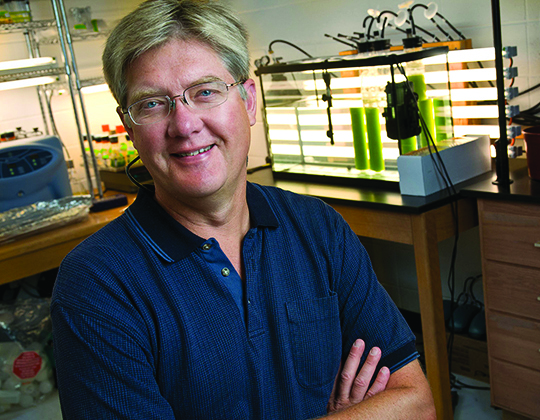
Brent Peyton and other MSU researchers will be expanding their investigations into how microorganisms thrive in the hostile conditions of Yellowstone’s hot springs.
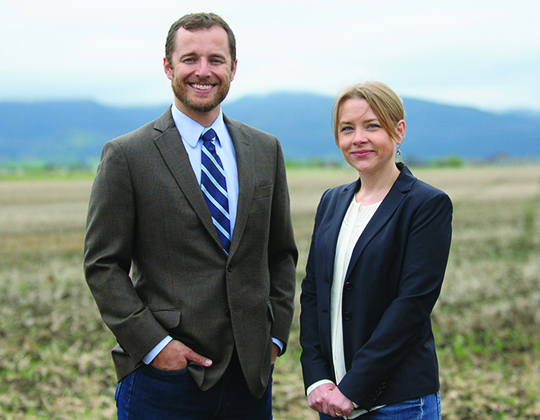
Kelly Knight and Colter Ellis, assistant professors in the Department of Sociology and Anthropology, have received a grant from the Montana Healthcare Foundation to research health disparities and victim service provider needs among American Indians in Montana.
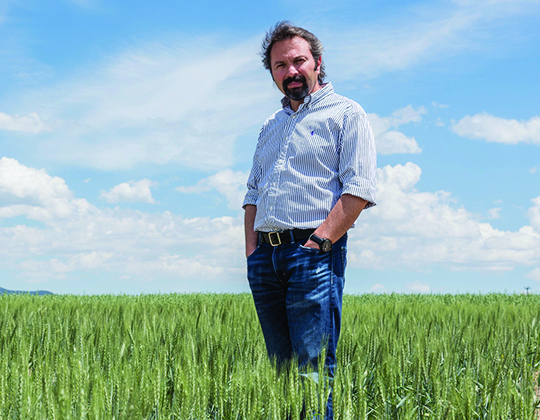
Hikmet Budak, MSU professor and Montana Plant Sciences Endowed Chair in the Department of Plant Sciences and Plant Pathology, recently collaborated with a team of international researchers on sequencing the genome of durum wheat, a staple ingredient in pasta.
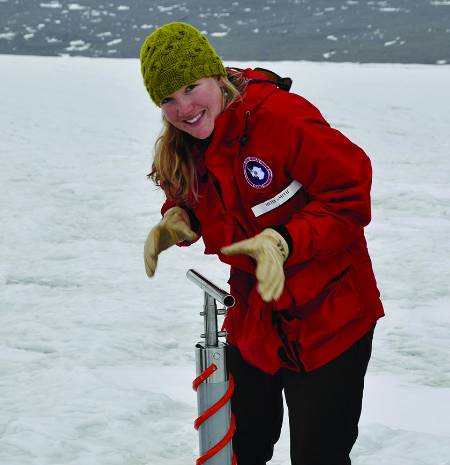
MSU-CBE doctoral graduate Heidi Smith was recently published in the journal Nature Biofilms and Microbiomes under the title “Biofilms on Glacial Surfaces: Hot Spots for Biological Activity.” The paper explains how bacteria may play a bigger role in the melting of glaciers than previously suspected.
Access Return to Top Progress Report 2016
Land-grant universities were established by Congress in 1862 with the explicit intent to educate the sons and daughters of the industrial classes. MSU continues to fulfill that intent, believing that education serves society as a whole through job creation, stronger civic participation, and a reduction in the societal costs borne by a less educated populace. MSU does not turn away qualified Montanans and will continue to provide access to a quality education for all students to improve the state and the well-being of its citizens.
Goal: Montana State University is committed to widening access to higher education and ensuring equality of opportunity for all.
Objective A.1: Educate more students while maintaining the quality of programs.
Objective A.2: Diversify the student body.
Strategies
- Enhance financial aid offerings, improve use of donated funds, and limit cost increases so that MSU remains affordable
- Address growing student debt issues through financial literacy programs, advising, appropriate course loads, and career coaching
- Expand course and program offerings, delivery times, and instructional methods to meet the needs of a more diverse student audience
- Dive deeply into retention and recruitment analysis to improve service to underrepresented groups
- Recruit and retain diverse faculty and staff
- Actively recruit from diverse student pools and support students with specific needs once enrolled at MSU, e.g. non-traditional aged students, veterans, and American Indian students
Budget alignment (2015–16 investments unless otherwise noted)
- $1.1 million in institutional scholarships for Montana students
- $300,000 institutional investment in financial literacy programs to minimize student debt
- Additional $575,000 invested in summer session to increase year-round access (also in Learning)
- $71,000 committed to Core at Night, expanding access to working adults
- $365,000 in institutional support for veterans through Yellow Ribbon
- $165,000 for Native American student recruitment, retention, and success strategies
- $60,000 strategic investment in partnership program with tribal colleges to develop articulation and advising relationships (also in Engagement)
Successes
- Financial Literacy Program Garners Spotlight — Bloomberg Television highlighted research around MSU’s “Know Your Debt” program to make students more aware of their debt load and what they need to do to
keep expenses under control. “What is amazing about this study is if you just give
(students) a little bit of information, they are going to make that change the next
semester,” Bloomberg’s Brendan Greeley said. Greeley also noted research by MSU economics
professors — Christiana Stoddard and Carly Urban as well as Maximilian Schmeiser,
an economist with the Federal Reserve Board — found that students receiving KYD letters
reduced their debt loads in the subsequent semester by about 1/3, took more credits,
and had higher GPAs in the subsequent semester.
- Military Friendly Universities — MSU and MSU Billings were named among the nation’s military friendly universities by the website MilitaryFriendly.com for its 2016 compilation of schools that support student veterans. At MSU, some 4 percent of the student body is made up of those with military service records. At MSU Billings, that number sits at 5 percent. Part of MSU’s attraction is financial assistance dedicated to veterans and their spouses, donated by several families in honor of their beloved veterans.
- Hot List for Native Students — Montana State was one of five “hot” universities for Native American Students highlighted in Indian Country Today. The newspaper cited MSU’s top 100 minority degree producer distinction from diverse education, degree programs in many sought-after programs such as sustainable food production, natural resources and rangeland ecology, and education, and its location in the beautiful Gallatin Valley as reasons for Native students to attend.
- International Appeal — MSU is number 282 nationally in the number of international students on campus, according to research conducted by the Institute of International Education. Seven hundred and twelve international students enrolled at MSU in Fall 2016, 56 more than the year before, for a growth rate of 8.86 percent. International students contribute to the local economy and bring unique perspectives to MSU’s classrooms, make important contributions to our research, and develop global understanding and friendships.
- Gallatin College MSU Scholarships — Improving access and success for local students, a significantly larger number of students enrolled in Gallatin College Montana State University received scholarships in 2015-16 thanks to the college’s success in a recent student scholarship fundraising initiative. In spring 2016, 87 Gallatin College MSU students received scholarships, compared with only seven scholarships awarded at the same time last year.
- Changing Culture in Engineering — The number of female undergraduate engineering students has increased 50 percent since 2012. Women faculty in the College of Engineering have nearly doubled in number from 13 to 25. The number of women faculty on the tenure track has increased from seven to 17. The college’s two associate deans are women, as are more than half its new hires. Also growing, say some women who work in the college, is a welcoming and inclusive culture that supports their success. As a result, engineering dean Brett Gunnink was named the inaugural winner of the Advocates and Allies Award, a national award given by the Women in Engineering Proactive Network.
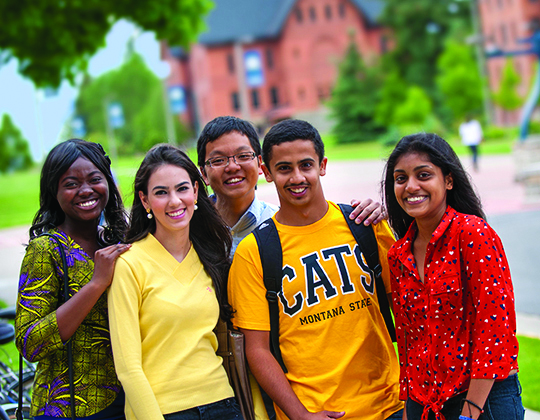
MSU is number 282 nationally in the number of international students on campus, according to research conducted by the Institute of International Education.
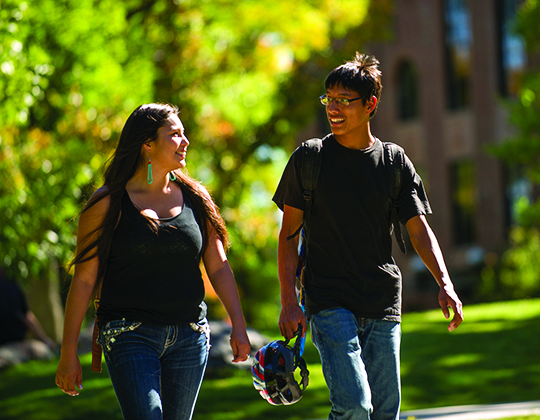
MSU was named to Indian Country Today’s “Hot List” of five universities Native students should check out because of the support and scholarships offered to Native students.
Stewardship Return to Top Progress Report 2016
As a public institution, MSU recognizes and honors its obligation to the many constituents who invest their time, financial resources, energy, and support. MSU deeply values the public trust granted to it and is committed to continued good stewardship of its resources.
Goal: As steward of a land-grant institution, MSU will responsibly manage its human, physical, economic, and environmental resources in an open and sustainable manner.
Objective S.1: Human Resources. Attract, develop, and retain the best faculty and staff to achieve
the MSU mission.
Objective S.2: Physical Resources. Enhance aesthetic appeal and functional quality of MSU physical
resources to support high quality learning, research, and work environments.
Objective S.3: Economic Resources. Increase and effectively allocate resources in support of the
MSU Strategic Plan.
Objective S.4: Environmental Resources. Promote sustainable stewardship and a culture of resource
conservation at MSU.
Strategies
- Retain our faculty and staff with market-based compensation and professional development opportunities
- Analyze and calibrate workload to meet the growing student body’s needs while encouraging focus on strategic priorities
- Leverage shared services where appropriate to maximize efficient and effective administrative processes
- Invest in functional and aesthetic improvements to our physical infrastructure
- Invest in energy saving building upgrades and minimize carbon footprint through reduced consumption and increased waste diversion
Budget alignment (2015–16 investments unless otherwise noted)
- $616,000 in market, merit, equity, and promotion increases for tenured and tenure-track faculty, $50,000 more than in FY15 (also in Discovery)
- $124,000 in additional salary to retain talented faculty (also in Discovery)
- $500,000 in faculty and staff professional development programs and support for individual faculty development opportunities
- New budget model incorporating forecasting, enrollment growth, and strategic investment pools developed in FY16 for allocation of FY17 budgets
- $1.5 million in new budget model strategic pools awarded for allocation in FY17 for strategic plan initiatives
- Efficiency and effectiveness gains through shared services center serving 20 units with just 4 FTE, with additional shared services models adopted by colleges and other units
- $1.4 million for utilities tunnel expansion to conserve energy and financial resources over time
- $750,000 for data center relocation to protect data resources
- $50,000 committed for covered bike parking pilot project to encourage alternative commutes
Successes
- STEM Equity — MSU’s NSF ADVANCE-funded initiative Project TRACS, which works to broaden the participation
of women faculty in science, technology, engineering, math and underrepresented areas
of social and behavioral science on the university’s campus, garnered attention from higher education human resources professionals. The fall issue of The Higher Education Workplace, a magazine published by the College and University Professional Association for
Human Resources noted that through the program, Montana State is “making an impact
not only at MSU, but throughout the state of Montana.”
- Best Place — The Arthur H. Post Teaching and Research Farm at MSU was ranked number 28 out of 40 of the best college farms nationwide. The rankings are based on hands-on experience, student involvement, community outreach programs, workshops, classes, lectures, volunteer opportunities and degree plan options. The farm encompasses more than 254 acres of wheat and barley variety trials, cropping systems, pest management studies, and trials for Foundation seeds, or seeds developed by the experiment station for potential commercial production.
- Efficient Networking — MSU recommitted to a partnership with the Pacific Northwest Gigapop, PWNG, a nonprofit networking group that serves research and educational organizations. The move not only upgraded MSU’s bandwidth to 30 gigabytes per second but also saved the university more than $100,000 per year in networking costs.
- Scholarly Waste Reduction — A team of MSU faculty members, students and staff have found that changes to the university’s recently renovated Miller Dining Hall, like using smaller serving utensils, serving smaller portion sizes, using smaller pans of food on the buffet and creating signs that state the amount of food that is wasted, have reduced food waste by more than 50 percent and improved campus sustainability. Carmen Byker Shanks and Selena Ahmed, assistant professors in the Department of Health and Human Development, and students and staff from MSU’s Department of Health and Human Development, Food and Health Lab, Sustainable Food Systems program, University Food Services, Office of Sustainability, Facilities Services, MSU Extension, Campus Sustainability Advisory Council and Sustainable Food and Bioenergy Systems and Food and Nutrition courses conducted the study.
- Generous Donors — What It Takes: The Campaign for Montana State University has garnered generous lead contributions from Bozeman residents Tim and Mary Barnard, the Gianforte Family Foundation, and the late Bill Wurst, a 1959 alumnus in electrical engineering for the College of Engineering and planned South Campus development. Funds will support People, Places, and Programs for current and future Bobcats.
- Recycle More, Trash Less — In 2015, MSU’s residence hall recycling tripled from 10,705 to 32,601 total pounds of recycled materials. To put the amount into perspective, 32,600 pounds is approximately equal in weight to about six cars. In addition, the amount of garbage going to the landfills from MSU’s residence halls was reduced from 11,540 pounds in spring semester 2014 to 7,460 pounds in spring semester 2015.
- Award Winning Design and Construction — Jabs Hall took first place for the best project in the higher education/research category in the mountain states region of the ENR Regional Best Projects Awards. The award came from ENR, or Engineering News-Record, a prominent magazine focused on the construction industry. The awards are given to celebrate and honor the building teams that created the best projects nationwide in 2015. The project won the award based on its performance in several categories, including teamwork and overcoming challenges, safety, innovation and contribution to industry, construction quality and design quality, according to Jake Van Dusen, project engineer with Dick Anderson Construction, who submitted information about the project to ENR.
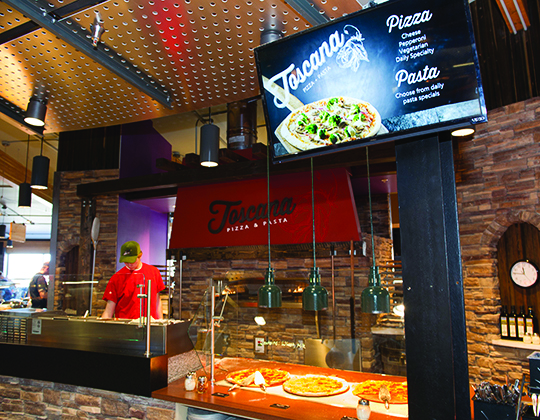
Miller Dining Commons was recently awarded the grand prize for residential dining concepts in the National Association of College and University Food Services’ annual Loyal E. Horton Dining Awards.

The nationally-ranked Arthur H. Post Teaching and Research Farm

Passive solar technology is working to lower energy costs at Jabs Hall.
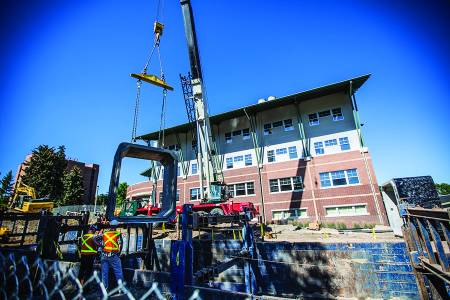
Work has begun on the heating infrastructure for the new dining hall to be built on the north side of campus.
Selected Plan Metrics Return to Top Progress Report 2016
|
Learning
|
2011-12
|
2012-13
|
2013-14
|
2014-15
|
2015-16
|
||
|---|---|---|---|---|---|---|---|
|
Objective L.2: Increase graduation rates at MSU. |
|||||||
|
L.2.1 |
Bachelor Graduation Rate (entering cohort from 6 years prior) |
51% |
49% |
50% |
50% |
52% |
|
|
L.2.3 |
Associate Degrees Awarded (Summer, Fall, Spring)* |
31 |
28 |
40 |
57 |
60 |
|
|
L.2.3 |
Workforce Certificates Awarded (Summer, Fall, Spring)* |
20 |
47 |
46 |
66 |
65 |
|
|
L.2.4 |
FTFTF Retention Rate (entering cohort from prior Fall) |
74% |
74% |
76% |
76% |
77% |
|
|
Objective L.3: Increase job placement and further education rates. |
|||||||
|
L.3.1 |
Employed in Major Field or Position of Choice (one year post-grad) |
63% |
64% |
66% |
68% |
71% |
|
|
L.3.2 |
Graduate School Enrollment (one year post-grad) |
22% |
18% |
23% |
16% |
18% |
|
|
Discovery
|
2011-12
|
2012-13
|
2013-14
|
2014-15
|
2015-16
|
||
|---|---|---|---|---|---|---|---|
|
Objective D.3: Expand the scale, breadth and quality of doctoral education. |
|||||||
|
D.3.2 |
Graduate student headcount |
1,965 |
1,888 |
2,030 |
2,050 |
1,981 |
|
|
D.3.2 |
Doctoral student headcount |
397 |
420 |
481 |
537 |
555 |
|
|
D.3.3 |
Graduate Degrees Awarded (Summer, Fall, Spring) |
591 |
557 |
562 |
673 |
600 |
|
|
D.3.3 |
Doctoral Degrees Awarded (Summer, Fall, Spring) |
53 |
49 |
56 |
79 |
60 |
|
|
Access
|
2011-12
|
2012-13
|
2013-14
|
2014-15
|
2015-16
|
||
|---|---|---|---|---|---|---|---|
|
Objective A.1: Educate more students while maintaining the quality of programs. |
|||||||
|
A.1.1 |
Montana Undergrad Headcount Enrollment (Fall) |
8,586 |
8,680 |
8,828 |
8,653 |
8,683 |
|
|
A.1.2 |
New Transfer Students (Summer and Fall) |
973 |
988 |
933 |
858 |
858 |
|
|
A.1.3 |
Graduate Student Headcount Enrollment (Fall) |
1,965 |
1,888 |
2,030 |
2,050 |
1,981 |
|
|
A.1.4 |
Online Credits (AY) |
14,755 |
16,212 |
20,327 |
21,027 |
20,406 |
|
|
A.1.4 |
Online Courses (AY) |
162 |
213 |
251 |
263 |
267 |
|
|
A.1.5 |
Gallatin College Headcount Enrollment (Fall)* |
199 |
228 |
324 |
440 |
450 |
|
|
A.1.6 |
Percent Financial Need Met (prior AY) |
74% |
72% |
72% |
74% |
75% |
|
|
A.1.7 |
Total Headcount Enrollment (Fall) |
14,153 |
14,660 |
15,294 |
15,491 |
15,688 |
|
|
Objective A.2: Diversify the student body. |
|||||||
|
A.2.1 |
Native American Student Headcount Enrollment (Fall) |
545 |
580 |
558 |
587 |
578 |
|
|
A.2.2 |
Other Under-Represented Ethnicity and Race Headcount Enrollment (Fall) |
947 |
1,065 |
1,193 |
1,191 |
1,174 |
|
|
A.2.3 |
International Student Headcount Enrollment (Fall) |
553 |
599 |
608 |
673 |
706 |
|
|
A.2.4 |
Nontraditional Age Student Headcount Enrollment (Fall) |
2,655 |
2,781 |
2,693 |
2,518 |
2,410 |
|
|
Stewardship
|
2011-12
|
2012-13
|
2013-14
|
2014-15
|
2015-16
|
||
|---|---|---|---|---|---|---|---|
|
Objective S.2: Physical Resources. Enhance aesthetic appeal and functional quality of MSU physical resources to support high quality learning, research and work environments. |
|||||||
|
S.2.1 |
Percent of classrooms with technology rated tier 3 or above (Recorded periodically)† |
2% |
6% |
7% |
12% |
— |
|
|
S.2.1 |
Percent of classrooms with technology rated tier 2 (Recorded periodically)† |
58% |
62% |
62% |
67% |
— |
|
|
Objective S.4: Environmental Resources. Promote sustainable stewardship and a culture of resource conservation at MSU. |
|||||||
|
S.4.1 |
Greenhouse Gas Emissions (Metric Ton CO2 equivalent) |
64,412 |
64,909 |
60,913 |
60,629 |
— |
|
|
S.4.2 |
Diverted waste from landfill |
9.5% |
9.2% |
11.8% |
15.8% |
19.2% |
|
* Gallatin College began awarding degrees and certificates in 2010-11
† Expanded list of included instructional spaces in 2013 and 2015
MSU by the Numbers Return to Top Progress Report 2015
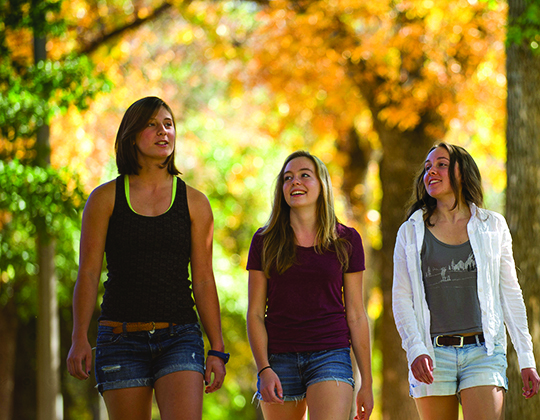
Student enrollment continues to grow and freshman academic profile continues to increase.
Enrollment
|
Fall 2015 Undergraduate Headcount Enrollment |
13,707 |
|
Fall 2015 Graduate Headcount Enrollment |
1,981 |
Faculty
|
Fall 2015 Full-time Faculty |
581 |
|
Fall 2015 Part-time Faculty |
403 |
|
Student to Faculty Ratio |
19:1 |
Degrees
|
2015-16 Certificates and Associate Degrees Awarded |
125 |
|
2015-16 Bachelors Degrees Awarded |
2,278 |
|
2015-16 Master Degrees Awarded |
540 |
|
2015-16 Doctoral Degrees Awarded |
60 |
Fall 2015 Enrollment by College
|
|
Undergrad |
Graduate |
Total |
|
Agriculture |
949 |
194 |
1,143 |
|
Arts & Architecture |
1,093 |
93 |
1,186 |
|
Business |
1,349 |
32 |
1,381 |
|
Education & HHD |
1,409 |
411 |
1,820 |
|
Engineering |
3,404 |
207 |
3,611 |
|
Graduate School |
0 |
313 |
313 |
|
Letters & Science |
3,155 |
501 |
3,656 |
|
Nursing |
897 |
82 |
979 |
|
Gallatin College |
450 |
0 |
450 |
|
University College |
1,001 |
0 |
1,001 |
|
Other |
0 |
148 |
148 |
|
Total |
13,707 |
1,981 |
15,688 |
Fall 2015 Enrollment by Gender
|
Female |
7,239 |
|
Male |
8,414 |
|
Other/No Response |
35 |
Fall 2015 Enrollment by Race and Ethnicity (individuals may be counted more than once if self-identified with more than one race or ethnicity)
|
American Indian/Alaska Native |
578 |
|
Asian |
605 |
|
Black/African American |
200 |
|
Hispanic |
610 |
|
Native Hawaiian/Pacific Islander |
92 |
|
White |
14,386 |
|
International |
717 |
|
Unknown/Other |
296 |
Fall 2015 Undergraduate Enrollment by Age
|
Under 24 years old |
11,297 |
|
24 years old and older |
2,410 |
First-Time Full-Time Freshmen
|
High School GPA |
3.45 |
|
ACT Comprehensive Score |
25.4 |
|
SAT Score |
1,722 |
Employees
|
Fall 2015 Full-time Employees, including Faculty |
2,334 |
|
Fall 2015 Part-time Employees, including Faculty |
753 |
